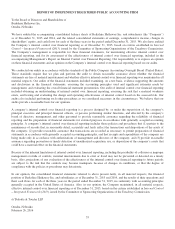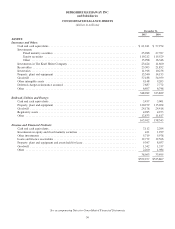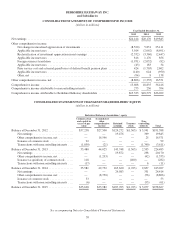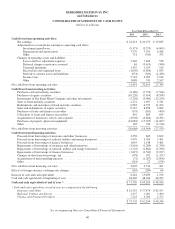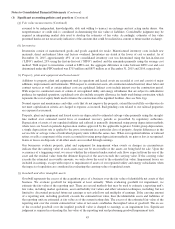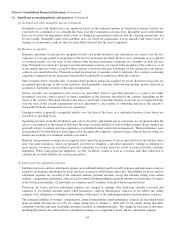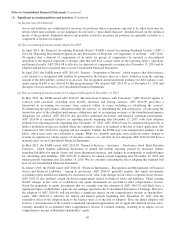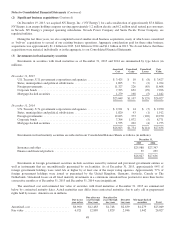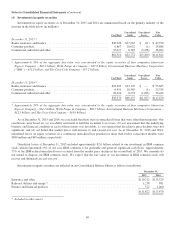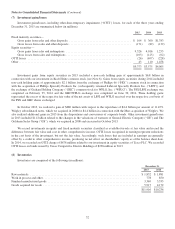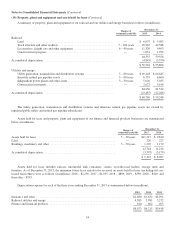Berkshire Hathaway 2015 Annual Report Download - page 47
Download and view the complete annual report
Please find page 47 of the 2015 Berkshire Hathaway annual report below. You can navigate through the pages in the report by either clicking on the pages listed below, or by using the keyword search tool below to find specific information within the annual report.Notes to Consolidated Financial Statements (Continued)
(1) Significant accounting policies and practices (Continued)
(m) Deferred charges reinsurance assumed
The excess, if any, of the estimated ultimate liabilities for claims and claim settlement costs over the premiums earned with respect
to retroactive property/casualty reinsurance contracts is recorded as a deferred charge at inception of the contract. Deferred charges
are subsequently amortized using the interest method over the expected claim settlement periods. Changes to the estimated timing
or amount of future loss payments produce changes in unamortized deferred charges. Changes in such estimates are applied
retrospectively and are included in insurance losses and loss adjustment expenses in the period of the change.
(n) Insurance policy acquisition costs
Incremental costs that are directly related to the successful acquisition of insurance contracts are capitalized, subject to
ultimate recoverability, and are subsequently amortized to underwriting expenses as the related premiums are earned.
Direct incremental acquisition costs include commissions, premium taxes, and certain other costs associated with
successful efforts. All other underwriting costs are expensed as incurred. The recoverability of capitalized insurance
policy acquisition costs generally reflects anticipation of investment income. The unamortized balances are included in
other assets and were $1,920 million and $1,722 million at December 31, 2015 and 2014, respectively.
(p) Life, annuity and health insurance benefits
Liabilities for insurance benefits under life contracts are computed based upon estimated future investment yields, expected
mortality, morbidity, and lapse or withdrawal rates and reflect estimates for future premiums and expenses under the
contracts. These assumptions, as applicable, also include a margin for adverse deviation and may vary with the characteristics
of the contract’s date of issuance, policy duration and country of risk. The interest rate assumptions used may vary by
contract or jurisdiction and generally range from less than 1% to 7%. Annuity contracts are discounted based on the implicit
rate of return as of the inception of the contracts and such interest rates generally range from less than 1% to 7%.
(q) Regulated utilities and energy businesses
Certain energy subsidiaries prepare their financial statements in accordance with authoritative guidance for regulated
operations, reflecting the economic effects of regulation from the ability to recover certain costs from customers and
the requirement to return revenues to customers in the future through the regulated rate-setting process. Accordingly,
certain costs are deferred as regulatory assets and obligations are accrued as regulatory liabilities. These assets and
liabilities will be amortized into operating expenses and revenues over various future periods.
Regulatory assets and liabilities are continually assessed for probable future inclusion in regulatory rates by considering
factors such as applicable regulatory or legislative changes and recent rate orders received by other regulated entities. If
future inclusion in regulatory rates ceases to be probable, the amount no longer probable of inclusion in regulatory rates is
charged or credited to earnings (or other comprehensive income, if applicable) or returned to customers.
(r) Foreign currency
The accounts of our non-U.S. based subsidiaries are measured, in most instances, using the local currencies of the
subsidiaries as the functional currencies. Revenues and expenses of these businesses are generally translated into U.S.
Dollars at the average exchange rate for the period. Assets and liabilities are translated at the exchange rate as of the end
of the reporting period. Gains or losses from translating the financial statements of foreign-based operations are included
in shareholders’ equity as a component of accumulated other comprehensive income. Gains and losses arising from
transactions denominated in a currency other than the functional currency of the reporting entity are included in earnings.
(s) Income taxes
Berkshire files a consolidated federal income tax return in the United States, which includes our eligible subsidiaries.
In addition, we file income tax returns in state, local and foreign jurisdictions as applicable. Provisions for current
income tax liabilities are calculated and accrued on income and expense amounts expected to be included in the income
tax returns for the current year. Income taxes reported in earnings also include deferred income tax provisions.
Deferred income tax assets and liabilities are computed on differences between the financial statement bases and tax bases of
assets and liabilities at the enacted tax rates. Changes in deferred income tax assets and liabilities that are associated with
components of other comprehensive income are charged or credited directly to other comprehensive income. Otherwise,
changes in deferred income tax assets and liabilities are included as a component of income tax expense. The effect on deferred
income tax assets and liabilities attributable to changes in enacted tax rates are charged or credited to income tax expense in the
period of enactment. Valuation allowances are established for certain deferred tax assets when realization is not likely.
45


